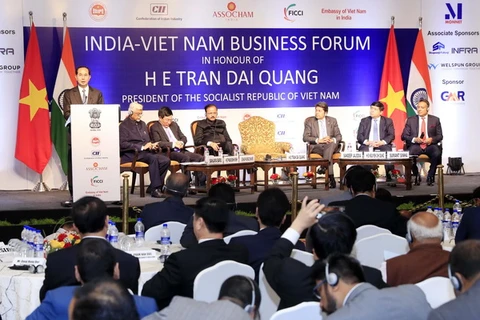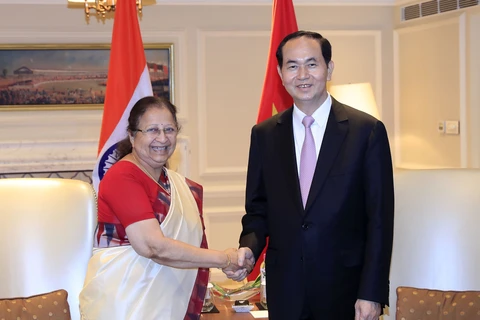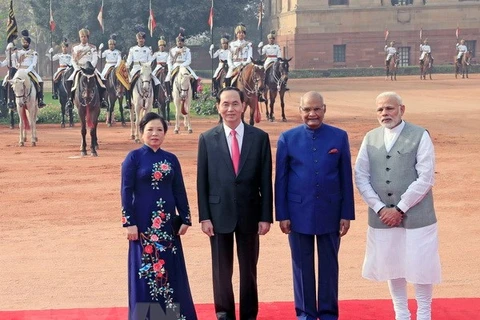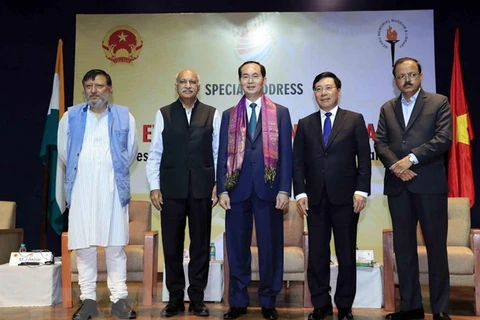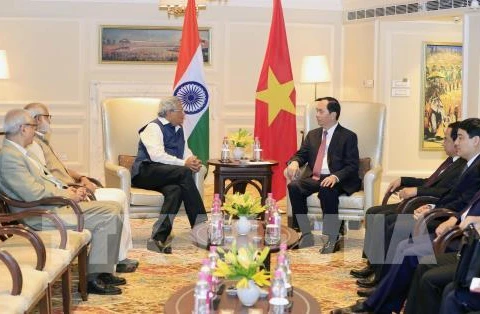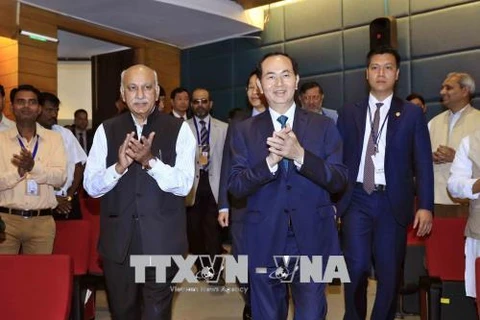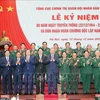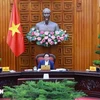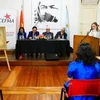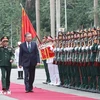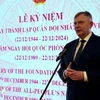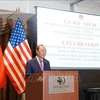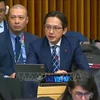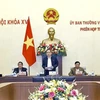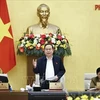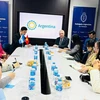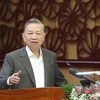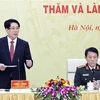New Delhi (VNA) - Vietnamese President Tran Dai Quang talked with nearly 300 Indian politicians, professors, researchers, scholars and students at the Nehru Memorial Museum and Library in New Delhi on March 4 morning (local time) during his three-day State visit to India.
The following is the full text of President Tran Dai Quang’s speech at the event.
VIETNAM – INDIA: STRENGTHENING COMPREHENSIVE STRATEGIC PARTNERSHIP FOR THE INTEREST OF THE TWO PEOPLES; FOR PEACE, STABILITY AND PROSPERITY IN THE REGION AND THE WORLD
Ladies and Gentlemen,
Namaste,
I am very pleased to have the opportunity to be here and speak with the politicians, professors, researchers, scholars, and students at the Nehru Memorial Museum & Library, the place which enshrines the historic relics of the life and work of Jawaharlal Nehru - a great Indian leader whose entire life was devoted to India's freedom and independence, and to peace and friendship among nations. To President Ho Chi Minh and the people of Vietnam he was a great and close friend.
At the beginning may I express my gratitude to the Indian Government, the Indian Foundation, and to all of you present here, for making possible this meaningful gathering. Your presence here is a strong expression of the interest in relations between Vietnam and India and the desire to join hearts and hands for peace, stability, cooperation, and development in the Indian Ocean and the Asia-Pacific.
Ladies and Gentlemen,
During these first two decades of the 21st century our world has witnessed many rapid, profound, and comprehensive changes. One of the most dramatic and inspirational of them all is the rise of Asia.
Just a hundred years ago the vast majority of the continent, India and Vietnam included, lay engulfed in the long darkness of colonialism, wars, and backwardness. Few could have imagined that one century from those dark days, Asia would rise to become a geo-politic, geo-economic, and cultural center of the world. Almost every global forecast today agrees on one thing: this century shall be the Asian Century.
Within only a few decades the world has witnessed the miracles of India, China, Japan, the Republic of Korea, and the ASEAN countries. It is a fascinating coincidence that all of these miracles have converged around the Indian Ocean and the Asia-Pacific.
Along with globalization and regionalization, the trends of linkage and integration, and the impacts of the revolution in science and technology, our region in recent years has yielded a cornucopia of long-term ideas, initiatives, and strategies for cooperation that are both inter-regional and global in scope. I would like briefly to name a few: the Regional Comprehensive Economic Partnership Agreement between ASEAN and its six partners; India's “Act East” Policy; China's “Belt and Road Initiative”; Japan's “Free and Open Indo-Pacific Strategy”; the United States' “Free and Open Indo-Pacific Vision”; and, most recently, the establishment of the Comprehensive and Progressive Agreement for Trans-Pacific Partnership, joined by eleven economies on both sides of the Pacific.
All these undertakings are raising the status and attractiveness of our region to a new level never seen before in history. Should all of the aforementioned come to fruition as per the statements of their founders, we will see the creation of a new space of security and development, comprising the Indian Ocean, Asia and the Pacific, hereafter called the Indo-Asia-Pacific. The ever-closer economic, political, and cultural ties between the Asia-Pacific and the Indian Ocean will create a new driver for growth and help transform the Asian Century into the Indo-Asia-Pacific Century.
Consequently, India and Vietnam shall both be part of a vast community accounting for 60% of the Earth's land area, 50% of world population, and a greater share of global GDP, trade, investment, and capacity for innovation. ASEAN and India shall become an integration hub with an essential role in the region’s future development.
Ladies and Gentlemen,
The achievements of the past decades in the Indo-Asia-Pacific provide a solid foundation to further strengthen and foster friendship and cooperation between countries both within and outside of the region, thus enabling us to make greater contributions to mankind.
However, our region is also facing notable intertwined challenges. In addition to being the convergence point of many initiatives for integration and cooperation, the Indo-Asia-Pacific is also a core theater in the competition for power and influence among major powers.
Furthermore, issues include regional hot-spots; armed conflicts; land, sea, and island sovereignty disputes; contested natural resources; international terrorism and transnational crime; and environmental pollution and climate change among others, all are evolving at an ever-greater scope, frequency, and level, with more serious characteristics. There remains a stark contrast between cooperation and competition, between moderation and extremism, between openness and isolation, between liberalism and protectionism, between development and stagnation, between independence and dependence, between unity and division. The desire for peace, stability, cooperation, and development in the Indo-Asia-Pacific has yet to be truly realized.
Shall this century become the Indo-Asia-Pacific Century? Shall this region truly become a hub connecting resources and harmonizing interests for continuous, more dynamic, and more sustainable development?
This aspiration will only come true when all countries share a common vision for an open and rules-based region, and a common interest in the maintenance of peace, stability, and inclusive prosperity, wherein no country, no nation, and no group shall be left behind.
This aspiration will only come true when all countries join together in the effort to protect the freedom of navigation and unimpeded trade and not let the Indo-Asia-Pacific be balkanized into spheres of influence manipulated by power politics, hindered by protectionism, or divided by narrow nationalism.
This aspiration will only come true when countries stand side by side to build a common space for co-existence and development in the belief that the Indo-Asia-Pacific is vast enough for every country to flourish and prosper.
This aspiration will only come true when all countries make the effort to establish effective mechanisms to maintain peace, stability, and the rule of law, so as to ensure the common security, prevent conflict and war, and effectively address security challenges both traditional and non-traditional.
Ladies and Gentlemen,
The Indian national hero Mahatma Gandhi once urged “You must be the change you wish to see in the world”. This could not be truer: the realization of this aspiration depends to a large extent on the capacity and the will of all countries in the region -- India, Vietnam, and ASEAN included -- to join hands in cooperation.
Geographically, India and ASEAN lie at the heart of the Indo-Asia-Pacific. Historically, over the last twenty centuries the peoples of India and Southeast Asia have come together bound by the values of peace, humanism, and fraternity. Today, India is marked by rapid and sustainable development that makes an ever-greater contribution to peace, stability, and prosperity in the region. ASEAN is characterized by being resilient, united, cohesive, well-integrated, and open in its cooperation, playing an expanding role in the region. These work together as paramount components of peace, cooperation, and development in the region as a whole. Herein lies our common interests and shared vision, one in line with the path to development and the constantly-growing status and stature of both India and ASEAN in the international arena.
For these reasons, ASEAN has strong faith and great expectations in the vigorous growth of India, a power that is deeply aware of her responsibilities and duties towards the international community. India shall become a new pole of development, an important engine for peace, prosperity, and integration both in the Indo-Asia-Pacific and the world at large.
We wish to express our gratitude for, and most highly appreciate, The Honorable Prime Minister Narendra Modi's statement at the ASEAN–India Summit in November last year: that India's “Act East” policy “is shaped around ASEAN, and its centrality in the regional security architecture of the Indo-Pacific region”. With this policy, India has been making efforts to forge substantive links, engage in deeper economic and political integration, and foster people-to-people ties with the ASEAN countries. It is obvious that only through ever-closer connectivity in infrastructure, trade and investment, culture, education and training, and science and technology, and many other fields can India and ASEAN amplify their strength, building together upon their roles and status so as to build a common development space for peace, stability, cooperation, and development, one that can more effectively respond to external shocks and challenges. The 25 years of ASEAN-India relations stand as a testimony to this. Over the next 25 years, given new opportunities and challenges, strengthening ASEAN-India ties must be both an objective necessity and a strategic choice for our two sides.
Ladies and Gentlemen,
Vietnam–India diplomatic relations are about to celebrate their semi-centennial, yet the close ties between our two lands and peoples have existed for thousands of years. Such links stem not only from shared interests but also from the profound and enduring cultural values that we share.
As early as the 1st century CE, the venerable monk Mahajivaka introduced Buddhism from India to Vietnam. The religion spread rapidly, for its cultural and spiritual values resonated well with our native beliefs. The ideas of equality, fraternity, anattā / anātman (non-self), and altruism that Buddhism represents have since taken root in the consciousness of the Vietnamese people and become in themselves inseparable parts of Vietnamese culture.
Since the 2nd century, Hinduism has also been present in Vietnam, its mark well-preserved in the Cham cultural relics in central Vietnam, the timeless epic of Ramayana, the character of Sita gifted with beauty and intellect, and the discipline of Yoga that is becoming ever-more popular in everyday Vietnamese life.
Today the works of the renowned cultural personality, poet, and philosopher Rabindranath Tagore - the first Asian Nobel Laureate in Literature -- still enchant the hearts of millions of Vietnamese with verses that hold within them profound philosophies about the universe, humanity, happiness, and love.
During the early 20th century the paths of our two countries' leaders converged in the struggle against colonialism for our two peoples' independence and freedom. As early as 1943, although imprisoned, the Vietnamese leader Ho Chi Minh composed these heartfelt verses addressed to Indian leader Jawaharlal Nehru:
“My cause striven, yours assayed,
To prison you went, in jail I stayed;
Though countless miles our meeting part,
Our sympathy, no words need impart.”
Exactly eleven years later, on 17 October 1954 -- just one week after the liberation of Ha-noi -- Prime Minister Nehru at the cordial invitation of President Ho Chi Minh became the first foreign head of state to pay a visit to Vietnam.
The image of our Indian brothers taking to the streets in support of the righteous resistance against American imperialism of the Vietnamese people, the slogan “Amar Nam, Tomar Nam, Vietnam, Vietnam, Ho Chi Minh, Dien Bien Phu” on their lips, shall be forever etched in the consciousness of the Vietnamese people. From the bottom of our hearts, we wish to express our deepest gratitude for the pure and sincere love, unfazed by hardship and unshaken by storm as it is, that the people of India have given to the people of Vietnam over the years.
Today, in a rapidly changing world we are proud to witness the traditional, faithful friendship between our two countries and peoples not just remaining true but even flourishing. Prime Minister Narendra Modi has stressed that, Vietnam is the top priority in the effort to strengthen India's relations with the Asia-Pacific. As seen from Vietnam’s foreign policy, India has always been one of the most important partners.
Exactly sixty years ago during his visit to India, our beloved President Ho Chi Minh asserted that “India is an independent and mighty nation that has made many invaluable contributions to peace in Asia and the world”. This observation remains relevant today. We are glad to note that in recent years India's rise has been closely linked with the prosperity and affluence of Asia as a whole. India's peaceful development has always worked as an important and constructive factor to regional peace and stability. With her vast potential and great contributions, India surely deserves a greater role in the Indo-Asia-Pacific region and the world.
For this reason, Vietnam welcomes India continuing to play her important role in the region. We consistently support your active participation in regional linkages and cooperation mechanisms, including APEC, as well as India’s becoming a Permanent Member of the United Nations Security Council.
Today our two countries have established a Comprehensive Strategic Partnership, setting forth our similar interests and values as well as our understanding and position regarding regional and global issues. Our two sides are working towards implementing the 2017-2020 Action Plan, already recording significant results. Political, defense, and security cooperation has all been expanded and become strategic pillars in our bilateral relations. Economic and trade cooperation is growing dramatically as well. Development cooperation and joint efforts in education, training, culture, tourism, and people-to-people exchanges are deepening, creating an enduring social foundation for our bilateral ties.
2017 was the “Friendship Year” celebrating the 45th anniversary of Vietnam–India cooperation. Our relations have entered a new period of development, and this requires renewed efforts and determination from both sides in order to realize always-greater achievements and live up to the expectations of our two peoples. The goal of our Comprehensive Strategic Partnership is nothing other than a strong and prosperous Vietnam that develops sustainably; a powerful India with growing prestige and status in the international arena; and our joint contribution towards the maintenance of peace, stability, cooperation, and development in the region and the world.
To this end, I wish to share with you some of my thoughts on the future direction of Vietnam–India relations.
First, we need to strengthen economic and trade connectivity as a pillar and driver of the Vietnam–India Comprehensive Strategic Partnership. Accordingly, we need to overcome the mentality of protectionism, promote trade/investment liberalization, and upgrade infrastructure, maritime and aviation connectivity in both the bilateral context and the framework of sub-regional and regional plans. Vietnam supports and will coordinate accordingly so that India will become an important element in the ASEAN Connectivity Master Plan, finalizing the Regional Comprehensive Economic Partnership Agreement in 2018.
We should promote maritime connectivity as a key area, not just in bilateral relations but also in the context of peace, stability and development in the Indo-Asia-Pacific region. Our two sides need to engage in regular information exchanges, experience-sharing, and capacity-building in handling maritime security matters. We should work together to develop a “blue-sea economy” through maritime connectivity, port cooperation, and environmental protection and the sustainable use of maritime resources. We should also make efforts to foster the maritime order and settle disputes peacefully on the basis of international law, including the 1982 United Nations' Convention on the Law of the Sea (UNCLOS).
Furthermore, we should strengthen connectivity in realizing the SDGs in both countries, closely linking the United Nations' 2030 Action Agenda to regional cooperation frameworks including the Mekong-Ganga mechanism. Vietnam hopes to effectively and substantively work with India in such areas as green agriculture, green technology, clean and renewable energy, capacity enhancement in information technology, disaster prevention and relief, and climate change response.
We should continue to work closely together in building a new and open regional architecture that is inclusive and shares the values and interests of peace. We should effectively implement all elements of the Vietnam–India Comprehensive Strategic Partnership and the ASEAN–India Strategic Partnership with a new vision. Good strategic partnership at all levels will yield benefits not only for Vietnam and India but also for peace and development in the region.
In addition, our two countries need to work together more closely in multilateral forums, in particular in UN and ASEAN mechanisms. We should more actively take part in building and shaping of cooperation frameworks and norms, making substantive contributions to the common efforts of the international community to ensure peace, cooperation and development, thus bringing about a brighter future for the Indo-Asia-Pacific.
Ladies and Gentlemen,
Prime Minister Nehru, the great friend of President Ho Chi Minh and the Vietnamese people, once said: “Time is not measured by the passing of years but by what one does, what one feels, and what one achieves”.
From the history spanning thousands of years of our two peoples' enduring cultural ties, from the heartfelt friendship between us, from our shared vision for the future -- and given the strong effort and determination of our two countries' leaders and peoples -- there is every reason to believe in an ever-flourishing Comprehensive Strategic Partnership between Vietnam and India. This indeed will become a pillar of regional integration and development, playing a key role in the 21st-century miracles of the Indo-Asia-Pacific and making significant contributions to peace, stability, cooperation and development in the region and the world.
May the Nehru Memorial Museum and Library continue to flourish, thus disseminating the values of humanism, fraternity, and peace that so characterize India to the region and to the world.
I wish you good health, happiness and success.
Thank you for your attention.-VNA

